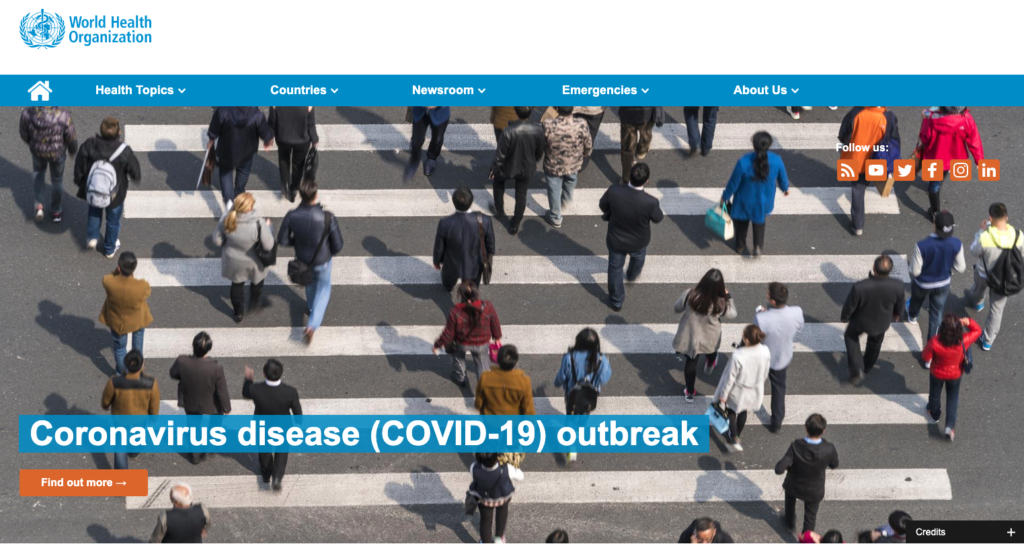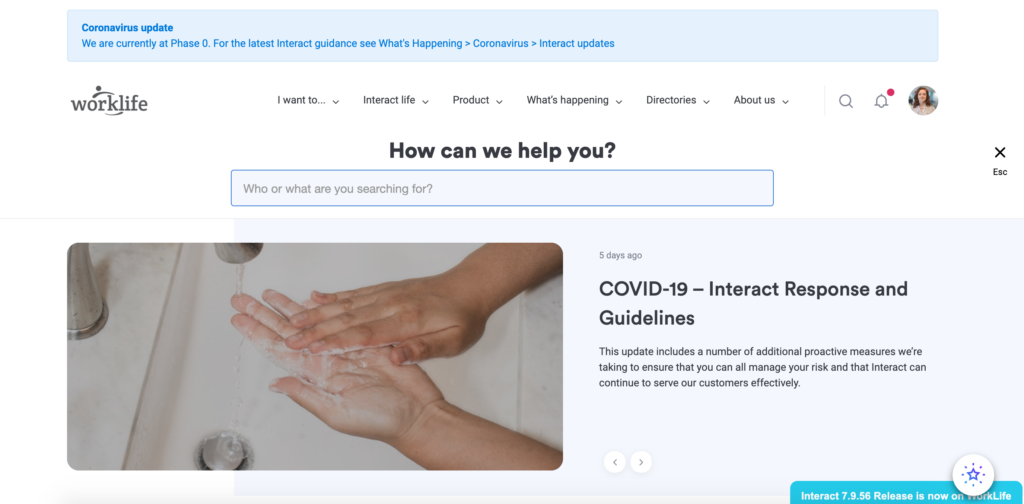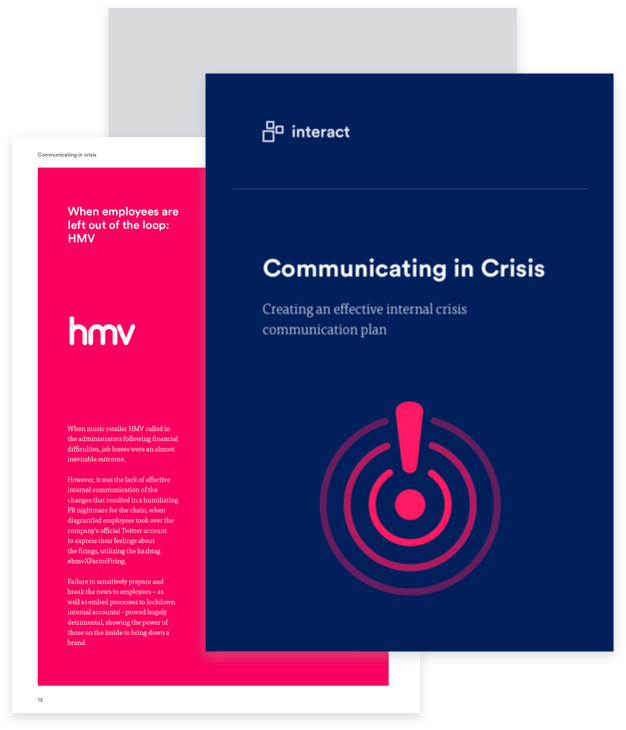As the situation around COVID-19 (commonly referred to as ‘coronavirus’) continues to develop, organizations globally are looking to internal communications to ensure employees are informed, safe, and productive.
As fast-changing news and guidelines continue to circulate around the developing COVID-19 situation, everyone is focused on keeping people around the globe safe and healthy.
Many organizations are taking proactive steps to evaluate the ever-changing situation and manage potential impact for staff and customers. In times of uncertainty or potential crisis, clear, reliable, and effective communication is vital.
However, given the sheer volume of information out there, it can feel like an overwhelming task for internal communicators and leaders.
We have a responsibility to our staff, who may find it difficult to separate out credible facts from the hype or have fears and concerns in the face of an outbreak. There may be an impact on both the individual and organization that we can’t even anticipate yet. As precautionary measures take effect over travel or working from home, we may be facing higher numbers of staff who need to work and obtain information differently from normal.
We also need to explain clearly what is happening and our response, without evoking unnecessary fear or worsening the situation.
Over the past week, we’ve been listening to those in charge of managing business communications and the ideas and challenges they face in relation to the coronavirus (COVID-19) situation.
Here, we share some of the ideas, approaches, and tips for communicating effectively with employees.
#1. Use official sources of information.
Ensure you’re referring to official sources of health information when communicating about COVID-19 in your organization. This reassures staff that you are using credible sources and presenting facts.
Rachel Miller of All Things IC has collated this excellent list of sources for accurate information. For organizations operating in the UK or US, guidance will primarily come from the World Health Organization (WHO), Public Health England (PHE), or U.S. Center for Disease Control (CDC).

#2. Create – or engage – your internal crisis team
If you already have a dedicated crisis or emergency team, now is the time to bring them together. While your location may not be facing an imminent risk, readiness for a change in situation can ensure you’re on the front foot.
If you don’t have a team, consider who from your internal network needs to be involved. Alongside senior authority/decision-makers, who can make important decisions quickly, you also need to consider those with tactical responsibilities or desired skills in the event of a situation escalating.
This may be, for example, IT representatives who can ensure staff are properly equipped to work from home, or those with written comms skills to help distribute information.
Creating an effective internal crisis comms plan
#3. Establish your source of truth and trusted communication channel(s)
If, like many organizations, you operate over several different communication channels – email, your intranet, Teams or Slack, manager cascades – you need to set out where employees should go for accurate, credible, and reliable information in a formal crisis communications plan.
Think about the suitability of the channel for the purpose. An ESN, for example, will typically be good for ‘moment in time’ and small snippets of information. For full and effective communication, you may need a platform where you can host long-form content, like your intranet software or company-wide email.
You also need to ensure it’s a channel that can be accessed by all staff, including those on the front line or working remotely.
#4. Designate authority figures and brief middle managers
Remember that not everyone will default to a communications channel when they have fears, concerns, or questions. Particularly in a high-stress situation, many will want to speak with someone they trust, and middle or line managers are often the first port of call.

While it’s probably not realistic that every middle manager has a place at the table when drafting your response plan, it’s still vital that they’re equipped with information on how to respond when staff approach them.
This can be as simple as activating a cascade and telling them who to ask or where to find answers. If possible, designate your ‘go-to’ figureheads for questions and provide middle managers with guidance around core procedures, how to manage staff fears, and what actions your organization is taking.
#5. Keep senior leaders visible
In times of uncertainty, stress, or pressure, steady and visible leadership is crucially important. The presence and words of an authoritative figure can provide much-needed reassurance and prevent any unnecessary escalation of panic.
Virtual town halls, company-wide intranet software updates or blogs, vlogs, a live stream, or a Teams or Yammer-facilitated Q&A are all great options for connecting staff with their leaders.
#6. Keep information current, relevant, and readable
If you have a working team who are meeting regularly to monitor the situation around COVID-19, establish timescales for giving staff regular updates.
It may be that you have a daily status update that states ‘No change’, but it will reassure staff that the situation is being continuously monitored and the information they’re reading is current.

Ensure that information issued is clear, accessible, and readable by all. Drowning staff in medical jargon will only make matters worse.
If you are issuing long statements or high volumes of information, consider supplementing it with some simple FAQs, myth busters, and jargon busters to address the top concerns: ideal for those who may skim-read through.
Creating an effective internal crisis comms plan
#7. Don’t let bureaucracy or red tape get in the way of effective communication
It follows the need to keep information current and relevant: don’t let unnecessary delays interfere with your management of the crisis.
Naturally, given the seriousness of the situation and the potential impact, we need to ensure the communications we’re issuing are factually correct and delivered in the appropriate tone and manner.
However, don’t fall foul of the ‘too many cooks’ syndrome. Over-management or complicated sign-off processes that demand every update go through several layers of approval will stand in the way of effective communication.
#8. Remember who you are communicating to – and listen
This may sound obvious, but when coming from your (usually senior-level) crisis team to then write up communications for your employees, you’ll normally find that they have different concerns and priorities. Your management may be concerned about business continuity or impact on operations, for example; that’s not likely to be the top staff concern.
To best way to approach this is by opening up two-way comms channels and listening to staff. This is not a time for top-down mandates. Give them the means to ask questions and raise concerns. What are the most important bits of information they want and need to know?

Perhaps they need clarification on what will happen in the event of school or childcare closures, for example, or what to do if they have travel planned to a high-risk region.
#9. Be sensitive to potential stress or anxiety
Even if your organization is considered low risk in terms of location or threat status, it’s important to recognize that staff may be experiencing uncertainty, anxiety, or confusion, particularly in the face of high volumes of information and social media or news stories.
You may also have staff who are considered high risk for health reasons, or have someone close to them who is.
Ensure all language used in communications is based in fact and considerate to those who may be experiencing stress. Encourage those with concerns to speak with their manager, HR, or your designated authority figure. Ask staff to be sensitive when talking about COVID-19 in an office environment.
#10. Give responses that are proportionate and appropriate
There has been a lot of talk about the impact of both the media and social media in creating additional stress around the current situation. In recent days we’ve seen panic-buying of antibacterial gels or hand sanitizers, stockpiling of essential household items, and a rise in individuals ‘self-isolating’.

While it’s important that individuals and organizations alike take practical and appropriate measures to do their part in preventing the community spread of the virus, it’s also vital that our internal communications don’t feed a sense of panic or scaremongering. Advising all staff to stockpile medication or food at this stage is unlikely to be beneficial.
Where staff have individual health needs or concerns, deal with these on a case-by-case basis.
Reiterate practical measures all staff should be taking in terms of washing their hands or contacting the correct authority for advice in the event that they feel unwell. Keep communications calm, don’t over-empathize risks, and provide guidance only on what your staff can control.
Creating an effective internal crisis comms plan
eBook
Creating an effective internal crisis comms plan
When crisis hits, organizations need to act fast. Having an effective crisis communication plan ensures you respond efficiently, minimize risk, and reduce negative impact. Download the free eBook
#11. Check and remind staff of your standard policies and procedures
This week, UK Prime Minister Boris Johnson announced short-term measures to help combat the spread of coronavirus COVID-19, including statutory sick pay from day one of illness, rather than day four. It’s hoped the move will prevent unnecessary spread by those staff concerned about the financial impact of taking leave from work.
In the current circumstances, it’s important to look to your own internal policies and assess how robust they are in supporting the containment of any spread or risk.

This includes paid time off, how to inform the organization if they feel unwell, any travel restrictions, what to do if they fear they’ve been exposed, and your remote working policies.
#12. Ensure staff are aware of what and how to talk to external parties
For your customer-facing staff in particular, there may be questions or concerns coming in that they need to manage. Ensuring your staff know not only what to say, but how to deliver communication in a calm, sensitive, and considerate manner, is crucial.

One of the great ideas we’ve seen from customers is the use of an ‘employee toolkit’, hosted centrally on the company intranet to include prepared or official statements, latest updates, actions being taken by the organization to maintain business continuity or safeguard, any business travel restrictions, a list of FAQs, and directions on what to do if staff are approached by the press or need to escalate an inquiry.
This ensures consistency in messaging and helps prevent speculative or incorrect information from circulating, which could worsen anxiety or impact on your external brand.
#13. Prepare and equip staff to work from home if necessary
Some organizations in both the UK and US have already taken the precautionary measure of having staff work from home, to minimize risk of exposure or spread – such as global employment search engine Indeed, or Google’s European headquarters in Dublin.
While the official guidance isn’t mandating this course of action in the UK or US at this point, it is wise to take steps to prepare for the possibility.

This includes identifying what equipment, software, and tools your staff need to operate remotely; whether staff have connectivity if required; and identifying those staff for whom remote work isn’t a possibility.
Consider not only productivity tools required to do their jobs, but issues such as signing on, security, and accessibility, ‘culture’ tools that ensure staff are informed and connected with their workplace and colleagues, such as an intranet, and comms options including virtual meetings and video conferencing.
Even if this doesn’t end up needing to be actioned, it’s an ideal opportunity to review your current digital workplace and flexible working options to futureproof your workforce and protect business continuity in the face of the unexpected.
#14. Look at your infrastructure
Shifting to an at-home workforce when you have primarily office-based operations can place an additional burden on your servers and IT infrastructure.
Check what additional support may be required and look to your providers for guidance on any extra measures that may be needed. If you experience downtime or disruption, do you have backup options? Are staff aware of what their responsibilities are? Can you communicate with staff and/or customers in the event that operations are disrupted?
#15. Ensure you have effective support and communication measures in place for remote staff
If you have a higher population of staff working from home due to travel restrictions or in-house guidance, be mindful that this change in working practice can come with challenges for some.

There is a higher risk of isolation or loneliness, of feeling ‘out the loop’, and challenges trying to collaborate with others. The resulting impact on morale, productivity and staff well-being needs to be taken seriously.
Ensure staff know how to use your intranet, ESN, or collaboration tools to stay connected.
Managers and teams may want to proactively set up informal ‘check-ins’ or daily virtual stand-ups, so remote workers have an opportunity to chat and connect. A dedicated Slack or MS Teams channel may also be a workable replacement option for watercooler chat.
#16. It’s a changing situation: be prepared to change your comms
It’s a fast-changing situation and new information is being issued almost by the hour. Despite this, we may not fully understand the scope of the COVID-19 coronavirus for some time yet.
We are acting on the information that we know in the moment. As long as you’re drawing that information from credible sources (see point 1) and aren’t claiming to be a medical expert in this field, you’re acting credibly.
However, information, guidance, and facts will change and shift. A willingness to be agile and reframe our position is essential. Avoid inertia simply because something is already in writing: it’s OK to change and evolve what you’re saying.
Communication is key.
There’s a lot of advice and guidance around how to manage the COVID-19 situation; but if one thing is clear, it’s that communication really is at the crux of successful management.
Yes, communicating regularly with customers or consumers about any impact on business continuity, hours, and service disruption will be undeniably important. Loss of customers and revenue are concerns for many.
However, from what we’re seeing, it’s internal communication that is continuing to dominate the agenda.
This comes down not only to our duty and responsibility for our employees – safeguarding against and managing any outbreaks or concerns impacting our staff – but also an awareness that in many industries, they will be the face of our business in how we manage external communications.
Our employees are our brand, our crisis comms team, our advocates. If they are to be empowered to manage and respond to our consumers, customers, and clients, they must have the information first.



